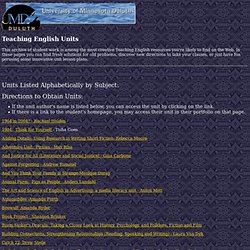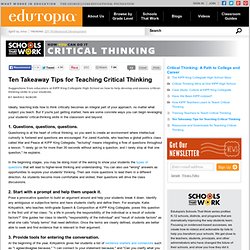

Teaching English Units. This archive of student work is among the most creative Teaching English resources you're likely to find on the Web.

In these pages you can find fresh solutions for old problems, discover new directions to take your classes, or just have fun perusing some innovative unit lesson plans. Units Listed Alphabetically by Subject: Directions to Obtain Units: If the unit author's name is listed below, you can access the unit by clicking on the link. If there is a link to the student's homepage, you may access their unit in their portfolio on that page. 1984 in 2004? 1984: Think for Yourself - Tisha Coen Adding Details: Using Research in Writing Short Fiction- Rebecca Moore Adventure Unit: Pirates - Max Rixe And Justice for All (Literature and Social Justice) - Gina Carbone Against Forgetting - Andrew Rummel And You Think Your Family is Strange-Monique Duray.
RubiStar Home. Year 10 history.
Hunger Games Paragraph. TECH WORKSHOP. School work. 25 TED Talks Perfect For Classrooms. The 50 Best Sources of Free STEM Education Online 12.05K Views 0 Likes Colleges, universities, and other educational forums in your community can be excellent places to learn more about a variety of STEM topics, but there is also a wealth of educational material available on the web for those who prefer to learn at their own pace or take a more individual approach.
Sst. Of Mice and Men.
Teaching (English/middle school) Ten Takeaway Tips for Teaching Critical Thinking. Suggestions from educators at KIPP King Collegiate High School on how to help develop and assess critical-thinking skills in your students.

Ideally, teaching kids how to think critically becomes an integral part of your approach, no matter what subject you teach. But if you're just getting started, here are some concrete ways you can begin leveraging your students' critical-thinking skills in the classroom and beyond. 1. Questions, questions, questions. Questioning is at the heart of critical thinking, so you want to create an environment where intellectual curiosity is fostered and questions are encouraged.
In the beginning stages, you may be doing most of the asking to show your students the types of questions that will lead to higher-level thinking and understanding. 2. Pose a provocative question to build an argument around and help your students break it down. 3. 4. 5. Lively discussions usually involve some degree of differing perspectives. 6. 7.
No, It’s Not Arbitrary and Does Make Sense: Teaching the English Punctuation System. You might also try putting a period at the end of a “thought.”

And what about semi-colons and colons? Well…maybe those are for exceptionally long breaths and thoughts? Okay, I guess you can see that these are no official “Strunk and White” rules about usage but rather the kind of myths about standard punctuation that are perpetuated, sometimes by educators, I’m afraid. Add to this the concern that writers, such as novelist and poets, often employ their own creative punctuation: for example, poet e.e. cummings wrote in all lower-case; popular novelist Stephen King, a former English teacher, writes long, run-on sentences to indicate stream-of-consciousness thought. So by the time students come onto a college campus, they’re often under the impression that punctuation doesn’t matter, or is arbitrary, and makes no sense—sometimes all three.
Learn. Together. Join the visual communication network.